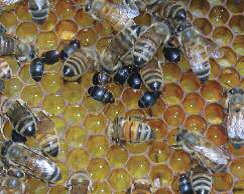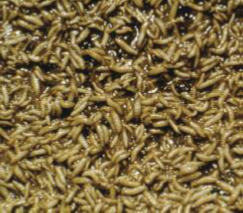Origins
Small hive beetle (Aethena tumida) is originally from sub-Saharan Africa where it is an insignificant pest – an inconvenience. It occupies a scavenger role – a sort of insect vulture – picking off weak African honey bee colonies and polishing off the dead. African honey bees have evolved defence mechanisms against the beetle…
Evolved Defence Mechanisms
African honeybees (Apis mellifera capensis) attempt to prevent beetle entry to colony but find it difficult to kill or eject them because of their shiny tough carapaces. They are unable to sting them so instead attempt to decapitate the beetles. Sometimes this tactic is successful but often the beetle responds – understandably – by tucking its head and legs in under the shell like a tortoise. Instead they have mastered the art of corralling the beetles in hive corners or crevices and propolising them in. This process can take a few days but during this time the bees guard the beetles and are able to keep them cornered until the propolising is complete.
In the meantime, the beetles are able to trick the bees into feeding them by stimulating the honeybee mouth-parts in the same way that drones do. Once the propolising is finished the beetles may be sealed in with full bellies after which they will cannibalise each other so it can be some time before the beetles die. If a beekeeper then comes along and opens the hive in the meantime he may also release the trapped beetles.
Other strong housekeeping instincts and behaviours cause the bees to be vigilant in the detection and removal of beetle larvae.
Features
Adult beetles are reddish brown to black in colour, oval in shape and between 5-7 mm long and
3-4.5 mm wide with ‘club shaped’ antennae. Here is a picture from UK’s Bee Unit.

European Honeybee Effects
Outside Africa, however, and in association with the European honeybee sub species A.mellifera.mellifera, A.m.ligustica and A.m.carnica small hive beetle is a proven devastating horror.
Here’s what they get up to with European honeybees:
- Adult beetles invade honeybee colonies and lay between 1 and 2000 eggs each;
- Beetle eggs hatch and the maggots begin to graze their favourite foods – honeybee eggs and larvae;
- If they can’t find bee larvae, they eat honey and pollen; there may be as many as 30 maggots per cell;
- Their activities destroy combs and start fermentation of honey with much slime as a result; in severe infestations the bees will abscond;

- When the maggots are mature they enter the ‘wandering phase’; this involves gathering together in corners or on the hive floor;
- They can survive in this phase for up to 48 days without food or water after which they will creep out of the entrance en masse;
- They then need to pupate and may wriggle as far as 20 metres in search of a suitable soil in which to burrow the required 10cm down or more commonly will burrow close to your hives;
- The ideal temperature for pupation is between 10 and 17 degrees Centigrade. In perfect conditions mature beetles can emerge in as little as 8 days! In less optimum conditions pupation can take longer; on average they will emerge in 3-4 weeks;
- Adult beetles will then take to the wing and seek another honeybee colony. They can fly up to 20km attracted by honeybee pheromones and the cycle begins again.
Spread
Small hive beetle can be imported with package bees, queen bees, bumble bees, comb honey, untreated beeswax, beehives and hive parts.
Control Measures
- Small hive beetle can overwinter with the bees so it can survive wherever there are bees. It is already present as far north as Canada and in balmier places such as Jamaica, Mexico. And now – Italy.
- According to the UK’s Bee Unit – “Small hive beetle cannot be eradicated once established”
- In US, 20,000 colonies had to be destroyed in the first two years since its discovery in 1998.
- It can be controlled by improved husbandry, honey handling and equipment storage procedures and the use of fierce pesticides which are illegal in the EU.
Click here for more on the treatment/control of Small Hive Beetle.
Sources
UK Bee Unit Information document http://www.nationalbeeunit.com/downloadDocument.cfm?id=17
P. Neumann, C. W. W. Pirk, H. R. Hepburn, A. J. Solbrig, F. L. W. Ratnieks, P. J. Elzen and J. R. Baxter. ‘Social encapsulation of beetle parasites by Cape honeybee colonies’ (Apis mellifera capensis Esch.) (2001)
Copyright © Beespoke.info, 2014. All Rights Reserved.
